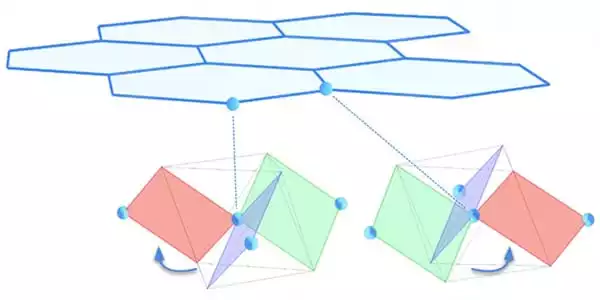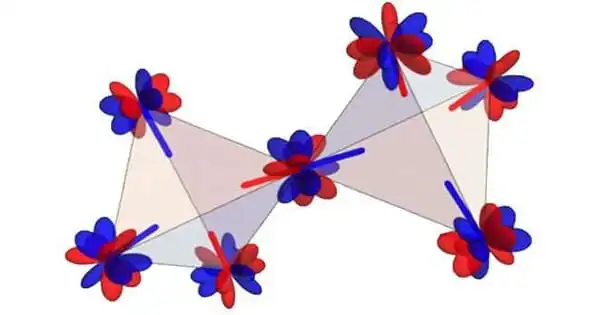Computational detective work by physicists in the United States and Germany has proven cerium zirconium pyrochlore is a 3D quantum spin liquid. Despite their name, quantum spin liquids are solid materials in which quantum entanglement and atom geometric organization defy electrons’ natural tendency to magnetically organize themselves in relation to one another. In a quantum spin liquid, geometric frustration is so severe that electrons oscillate between quantum magnetic states no matter how cold they become.
Theoretical physicists commonly work with quantum mechanical models that exhibit quantum spin liquids, but convincing evidence that they exist in actual physical materials has been a decades-long issue. While some 2D or 3D materials have been proposed as potential quantum spin liquids, Rice University physicist Andriy Nevidomskyy says there is no established consensus among physicists that any of them qualify.
Nevidomskyy hopes that will change as a result of the computational investigation he and colleagues from Rice, Florida State University, and the Max Planck Institute for Physics of Complex Systems in Dresden, Germany published this month in the open-access journal npj Quantum Materials.
“Based on all the evidence we have today, this work confirms that the single crystals of the cerium pyrochlore identified as candidate 3D quantum spin liquids in 2019 are indeed quantum spin liquids with fractionalized spin excitations,” he said.
Spin is an intrinsic characteristic of electrons that causes magnetism. Individual electron spins always point up or down when measured, just like a miniature bar magnet with a north and south pole. Spins in most ordinary materials point up or down at random. However, electrons are antisocial by nature, and in some cases, this might force them to arrange their spins in regard to their neighbors. Spins in magnets, for example, are oriented in the same direction collectively, whereas spins in antiferromagnets are structured in an up-down, up-down pattern.
Our modeling showed the exact quantities of interactions between these two components. It opens a new chapter in the theoretical understanding of cerium pyrochlore materials in general, as well as octupolar quantum spin liquids in general.
Andriy Nevidomskyy
At very low temperatures, quantum effects become more dominant, causing electrons in most materials, even those where spins would point in random directions at ambient temperature, to organise their spins collectively. Quantum spin liquids are an example of a material in which spins do not point in a certain direction – even up or down – regardless of how cold it becomes.
“By definition, a quantum spin liquid is a fractionalized state of matter,” said Nevidomskyy, an associate professor of physics and astronomy who is also a member of the Rice Quantum Initiative and the Rice Center for Quantum Materials (RCQM). “The individual excitations are not up-to-down spin flips or vice versa. They’re these bizarre, delocalized objects that carry half of one spin degree of freedom. It’s like half of a spin.”
Nevidomskyy participated in a 2019 study conducted by Rice experimental physicist Pengcheng Dai that discovered the first evidence that cerium zirconium pyrochlore was a quantum spin liquid. The samples provided by the team were the first of their kind: Pyrochlores because of the cerium, zirconium, and oxygen ratio of 2-to-2-to-7, and single crystals because the atoms inside were organized in a continuous, unbroken lattice. Dai and colleagues’ inelastic neutron scattering investigations showed a quantum spin liquid hallmark, a continuity of spin excitations detected at temperatures as low as 35 millikelvin.
“You could say that they caught the suspect and charged him,” Nevidomskyy added. “In this new study, our aim was to prove to the jury that the subject is guilty.”

Nevidomskyy and colleagues built their case utilizing cutting-edge Monte Carlo methods, accurate diagonalization, and analytical tools to perform spin dynamics calculations for an existing quantum mechanical model of cerium zirconium pyrochlore. The project was conceptualized by Nevidomskyy and Max Planck’s Roderich Moessner, and the Monte Carlo simulations were carried out by Florida State’s Anish Bhardwaj and Hitesh Changlani, with assistance from Rice’s Han Yan and Max Planck’s Shu Zhang.
“The foundation for this theory was known, but the particular parameters, of which there are at least four, were not,” Nevidomskyy explained. “These parameters may have various values in different compounds. Our goal was to find those numbers for cerium pyrochlore and see if they described a quantum spin liquid.
“It would be like a ballistics specialist utilizing Newton’s second law to compute a bullet’s trajectory,” he explained. “Newton’s law is well-known, but it only has predictive value if you specify the initial parameters, such as the bullet’s mass and initial velocity. These parameters are equivalent to the beginning circumstances. We had to reverse engineer, or sleuth out, ‘What are those starting circumstances inside this cerium material?’ and ‘Does that meet the forecast of this quantum spin liquid?'”
To make their point, the researchers compared the model to thermodynamic, neutron-scattering, and magnetization results from previously published experimental studies of cerium zirconium pyrochlore.
“If you just have one piece of evidence, you might inadvertently find several models that still fit the description,” Nevidomskyy said. “We actually matched not one, but three different pieces of evidence. So, a single candidate had to match all three experiments.”
Some research have suggested that the same type of quantum magnetic fluctuations that occur in quantum spin liquids could be the source of unconventional superconductivity. However, according to Nevidomskyy, the computational conclusions are largely of basic relevance to physicists.
“As physicists, this satisfies our basic drive to understand how nature works,” he remarked. “There is no application that I am aware of that would benefit. It is not directly related to quantum computing, while proposals for employing fictionalized excitations as a foundation for logical qubits exist.”
One particularly intriguing issue for physicists, he said, is the close relationship between quantum spin liquids and the experimental realization of magnetic monopoles, theoretical entities whose potential existence is still contested by cosmologists and high-energy physicists.
“When people talk about fractionalization, they mean that the system behaves as if a physical particle, such as an electron, divides into two halves that wander around and then reunite somewhere later,” Nevidomskyy explained. “These wandering objects also act like quantum magnetic monopoles in pyrochlore magnets like the one we analyzed.”
Magnetic monopoles can be represented as isolated magnetic poles, such as the upward or downward-facing pole of a single electron. “Of course, in classical physics, you can’t isolate just one end of a bar magnet,” he explained. “North and south monopoles are always found in pairs. However, magnetic monopoles can exist in theory in quantum physics, and quantum theorists built them about 100 years ago to investigate fundamental quantum mechanics concerns.
“As far as we know, magnetic monopoles do not exist in their pure form in our world,” Nevidomskyy explained. “However, it turns out that a more sophisticated version of monopoles occur in these cerium pyrochlore quantum spin liquids. A single spin flip creates two fractionalized quasiparticles called spinons that behave like monopoles and wander around the crystal lattice.”
The study also discovered evidence that monopole-like spinons were formed in cerium zirconium pyrochlore in a unique way. The study suggests that because of the tetrahedral configuration of magnetic atoms in pyrochlore, they form octupolar magnetic moments (spin-like magnetic quasiparticles with eight poles) at low temperatures. Spinons in the material were created by both these octupolar sources and more traditional, dipolar spin moments, according to the research.
“Our modeling showed the exact quantities of interactions between these two components,” Nevidomskyy explained. “It opens a new chapter in the theoretical understanding of cerium pyrochlore materials in general, as well as octupolar quantum spin liquids in general.”





